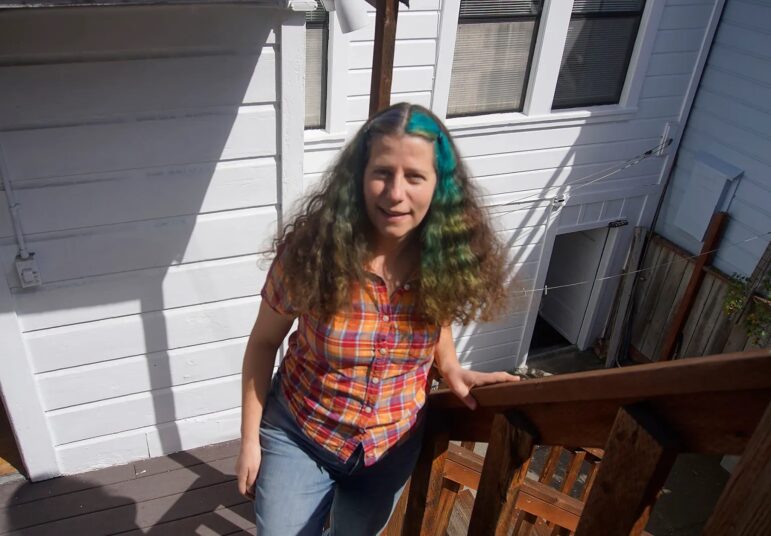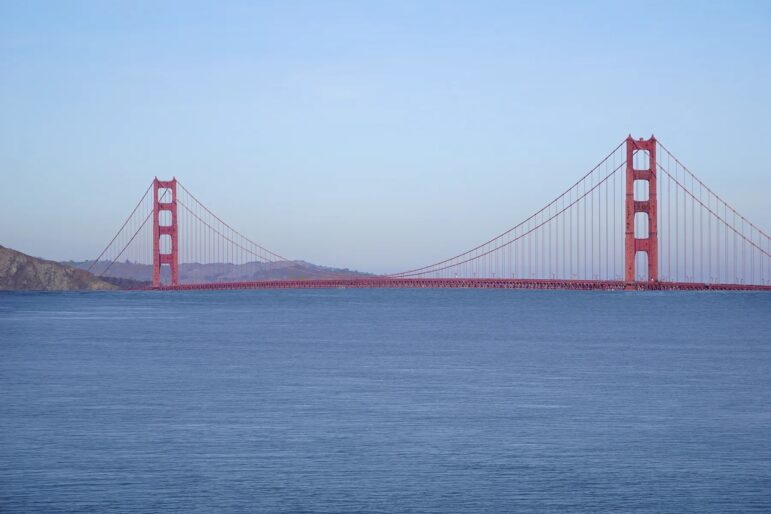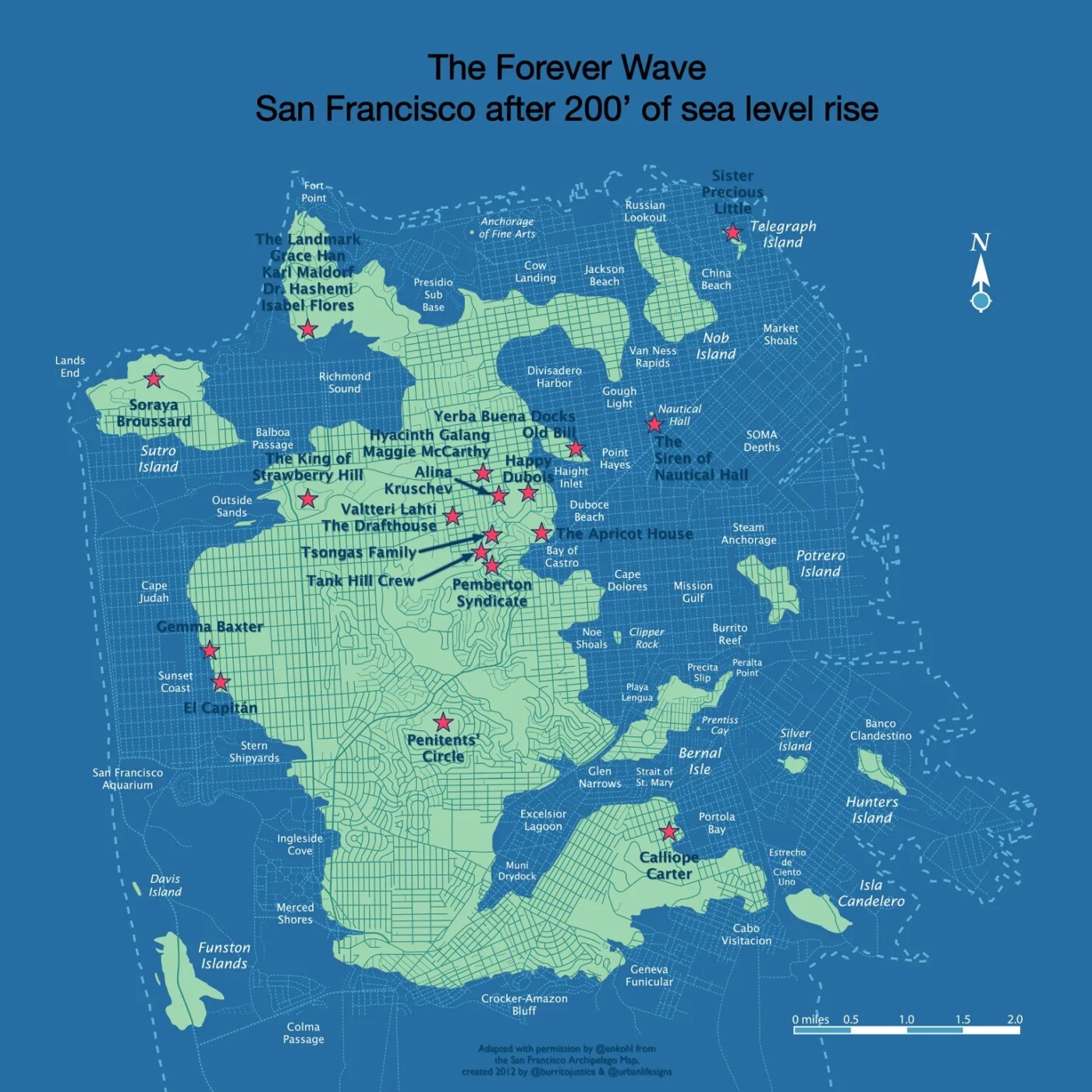Nicole Gluckstern, author of a new radio play, is a theater journalist who has written for KQED, Theatre Bay Area, and the San Francisco Bay Guardian; so it’s not a surprise that she began 2023 by co-founding the Bay Area art publication-co op Substrate Arts, or that she had been sitting on a climate crisis script she was ready to produce. Intriguingly, she chose to produce it as a radio play rather than a theatrical performance.
Inspired by a Dylan Thomas play, “The Forever Wave” takes place in a 2070 San Francisco almost unrecognizable due to sea levels having risen more than 200 feet. The survivors in the post-apocalyptic water world fight over limited land and resources in the play, which combines soundscapes, music and poetry in a story its writer-director calls “a comprehensive exploration of a what-if future that seems ever more likely every year we fail to address the impacts of climate change and economic inequality in our current timeline.”
In a recent interview, Gluckstern talked about the play, the changing physical and artistic climate of the Bay Area, and whether journalists might be replaced by artificial intelligence soon.
You’ve spent much of the past decade working as a theater journalist. Was there a period of adjustment in returning to the performance side?
Nicole Gluckstern: Not really. I’ve been making theater simultaneously all along. Performance and music and writing have all been my lifelong passions. I don’t really differentiate between them emotionally as they all stem from the same impulse for creation. My theater-making informs my journalism and my journalism informs my theater-making. It’s a nice symbiosis.
You mentioned in a letter to friends and colleagues that the still-ongoing pandemic has inspired you. Was “The Forever Wave” conceived as an audio-exclusive piece or did you perhaps envision it as a return to producing in-person shows?
So, the genesis of this piece was really my longtime ambition to stage the Dylan Thomas play “Under Milk Wood,” which I’ve been obsessed by for many years. I tried very hard to conceptualize what that play for voices would look like and feel like on a black box stage, and I kept not quite figuring it out. One thing the pandemic did give us as theater-makers was some space to think outside of the black box. And that’s really when I realized I’d been trying to tackle “Under Milk Wood” the wrong way all along. Because it was originally written and performed as a radio play. So, why not do it on the radio? That was a revelation for me. That of course I could create a piece that was a radio play and that was just as “legitimate” theatrically as forcing it onto a stage.
By the way, I am well aware that people have staged in-person productions of “Under Milk Wood” successfully. But the idea that it could remain a radio production was, for me, a necessary concept towards realizing it.
But then my next realization was that after all of this time being obsessed with “Under Milk Wood” and wanting to stage it and then figuring out how, I realized that the actual play no longer resonated for me in quite the same way. What does “Under Milk Wood” specifically have to say in conversation with the Bay Area of today? Why this play and why now is a question I think every theater-maker should ask themselves. So, my next challenge was to think about what ways did “Under Milk Wood” speak to our present moment, and could I make that a compelling enough case to produce it as written.
Ultimately, I decided I could not make that case for the original, and so instead I created this world that borrows heavily from the original concept and its structure but set specifically in the Bay Area and speaking directly to some of our contemporary concerns. It was really great to think about the original play as a framework for a new play. Identifying what were the things in “Under Milk Wood” that make it so special and so iconic, and then trying to incorporate some of those things into this futuristic world.

Given safety concerns and just the basic foibles of talent scouting, how did you go about casting and recording?
I was very, very, very lucky in that I knew pretty much exactly who I wanted to invite to be on the cast and that almost everybody I asked said yes. We had a development reading in August 2022 that included a couple of folks who were not able to participate in the final recording session, and a couple of folks joined the cast after that reading, but for the most part I knew from the beginning who my dream cast was and I am really beyond thrilled that they were interested. The recording process itself was quite challenging, because we did do it all remotely, and there was a pretty big learning curve for a lot of us on the technical side of things. But on the other hand, it was part of the challenge I set for this piece. Can we create theater and access theater and remain in community with each other fully remotely? I think so. I hope so.
Is there any levity or optimism to be found in a story about climate devastation?
I think people will find this to be a very optimistic tale on a lot of levels. I love a doom-laden post-apocalyptic narrative as much as the next nerd, but I also really wanted to keep “Under Milk Wood’s” essential joyfulness intact. For myself, a future where cooperative systems flourish, and mutual aid is the mechanism for survival resonates deeply, and I wanted to present that as a possibility within this heavily-impacted, climate-changed world.
For a story attempting to forecast the far future, what did researching look like?
While I won’t minimize the amount of research I had to do [myself], I will say that the truly heavy lift was already done by my longtime collaborator Burrito Justice and his friend-in-map-making Brian Stokle. In 2012, they co-created a map of San Francisco after a 200-foot sea level rise, which Burrito and I then adapted for this play. So, the part where I had to figure out what remains of the San Francisco we know today was basically already done. And even though this play is futuristic, it’s not what I would call “hard” science fiction. So, I don’t have to explain how the water level rose that high in such a short amount of time. I just get to say that it did and then move on with the storytelling. Art!

Speaking of changing landscapes: For many years, you were the press voice for the late, great EXIT Theatre. With crucial venues like that and PianoFight vanishing, where do you see independent theater artists turning in terms of open-minded (and affordable) venues?
This issue has been something I’ve been thinking about for a long time. For example, I ran a living room performance series, Salon San Carlos, for many years. By booking cherished artists on mini-tours of the living rooms of San Francisco, I really wanted to underscore that theater is not something that only happens in venues. Venues are containers where performance can happen in a proscribed manner, and that is one great method for creating and accessing work. But it is not the only way.
I’ve sat through so many shows at 49-100 seat venues where there were fewer than 10 audience members in attendance. Even the best possible shows suffer from that basic lack of audience energy and engagement. It’s really a waste of space at that point—and of very precious funds. Why not invite those same 10 people into a living room to watch a performance up-close and personal? Now you have a sold-out show, and you’ve created a special intimacy between audience and performer that’s difficult to achieve in a larger room. Or why not perform on the radio? I would never have been able to wrangle these same 12 actors into the same room at the same time for an in-person show unless I had an enormous stage and institutional funding and two years to plan it all out. But with a recording we could pull it off in one year, and I do hope that people consider this option to be a viable method for creating and disseminating work in the future as well.
You also recently co-founded the journalism co-op Substrate Arts. Given that both journalism and the arts are two arenas rarely invested in these days – and with AI technology threatening both – how is going “all in” on arts journalism sustainable?
I challenge an AI to write as deeply and as precisely and as thought-provokingly as any one of us on the Substrate Arts team! I don’t think it can be done. Though I did enjoy Lily Janiak’s experiment over at The Chronicle, I think that there will always be people who hunger for our Substrate Arts brand of “slow journalism.” We are writing for them. I hope they’ll consider it a project worth sustaining over time, but I guess we’re all about to find out!
Do you see in-person shows often during these days? Is there a particular innovation (including streaming) that catches your eye?
I took an extended pause from in-person shows through 2022, even when they started to come back to the stage in 2021. One reason being I couldn’t think of a single show that I would want to see so badly that it would be worth getting sick from. Another reason being I was finishing up a master’s degree at San Francisco State, co-founding a worker-owned arts magazine, and writing-producing this play, and I decided I needed to spend a little time focusing on my own projects and less on those of others. I did enjoy participating in certain innovations during that period—such as Oakland Theatre Project’s “drive-in” theater concept. And I’ve been very grateful to theatres that have kept the option of streaming open. I hope that continues to be a part of our theatrical convention moving forward.
What particular audience do you hope to reach with “The Forever Wave?”
It’s scary and also exhilarating to not be able to track exactly who will be attending the “run.” My goal was to make it as accessible as possible to folks in different areas of the Bay Area, and beyond. So we have evening broadcasts. Early morning streams. Evening and afternoon broadcasts and streams. And participating radio stations located in different neighborhoods and regions. We’ve announced performances over three weekends in March and four partner stations, but we have a few more in discussion and will likely run into April. I love touring work and I love the idea of a radio “tour” where folks who might never come out to San Francisco to see one of my shows might still be able to access it locally over the airwaves, or even globally over the internet.
In both a literal and creative world that seems increasingly bleak, what inspires you to continue creating?
We don’t know what of humanity will live on in the future. But a world without artistic endeavor doesn’t feel like a world I’d want to be a part of in any case.
“The Forever Wave” airs at 8 p.m. March 4-5 on KSFP 102.5 LP FM (also sfpublicpress.org/ksfp); 7:30 a.m. March 9 on BFF.fm; 8 p.m. March 10-11 on RadioValencia.fm; 8 p.m. March 17 on KACR-LPFM 96.1, Alameda (also kacr.airtime.pro); 2 and 10 p.m. March 19 on KACR-LP FM 96.1, Alameda (also kacr.airtime.pro); and 6 p.m. March 28 on KALW 91.7, San Francisco. It’s free to listen; donations are encouraged at https://estrellasuerteproductions.com/forever-wave/ .
